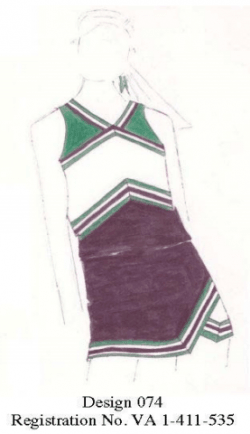What Do Costume Designers, Cheerleaders, and 3D Printing Companies Have in Common on Halloween?
October 2016What do costume designers, cheerleaders, and three-dimensional (3D) printing companies have in common on Halloween? They will all be tuned in to oral argument before the U.S. Supreme Court on October 31, concerning the copyright infringement case Varsity Brands v. Star Athletica. The parties' dispute is over whether the graphic design elements of cheerleading uniforms qualify for copyright protection.
Under the federal Copyright Act, the creators of artistic works receive the exclusive right to reproduce, distribute, and publicly display their projects. However, copyright protection is limited to creative expression and does not protect "useful" aspects of the work. For clothing, design elements such as sleeve length and neckline relate to the "useful" purpose of clothing the body, and thus they are not eligible for copyright protection. However, purely decorative elements, such as pictorial or graphic elements capable of existing independently of the clothing, can still receive copyright protection. This principle is known as the separability test. The cut or design of clothing is thus generally not protectable, but fabric designs might be. Halloween costumes, for example, are considered "useful," but many have elements that serve no useful purpose, such as masks and fairy wings. This can result in the situation where part of the costume is protected, and part is not.
In Varsity Brands v. Star Athletica, a cheerleading uniform designer sued a competitor, alleging infringement of various registered copyrights to "two-dimensional artwork" in the form of cheerleading uniform designs, including the following:

The defendant argued that the decorative elements of cheerleading uniforms, such as stripes, chevrons, and color blocks, are themselves utilitarian because these elements are the essence of what a cheerleading uniform is. If separated from the clothing, the defendant argued, it is no longer a "cheerleading" uniform. The trial court agreed and threw out the copyrights, concluding that the graphic elements of the uniform designs fail the separability test.
However, on appeal, the Sixth Circuit reversed, concluding that the useful elements of a cheerleading uniform are to clothe the body, wick away moisture, and withstand the rigors of athletic movement, and that the stripes, chevrons, and color blocks are purely decorative and separable from those uses. The Circuit Court noted that an unadorned uniform still serves these useful purposes. The Circuit Court also rejected the argument that the decorative elements are utilitarian, as this would make all fabric designs, whose only function is to make a garment more attractive, ineligible for copyright protection.
The defendant has appealed to the U. S. Supreme Court. The Copyright Office has a lengthy tradition of registering copyrights to pictorial and graphic design elements of clothing, and the government supports the position of the copyright owner, Varsity Brands. Also interested in the outcome of the case are 3D printing companies, who use additive manufacturing to produce objects that may be both decorative and useful. In an amicus brief filed in the case, a group of 3D printing companies urged the Supreme Court to establish a single, clear separability test so that 3D printing companies can understand and control their liability.
The courts have long struggled to develop a clear framework for distinguishing between the expressive and useful aspects of objects, and prior Supreme Court guidance on the subject is limited. The result is a fractured copyright system where different rules apply in different parts of the country. Copyright owners are hopeful that the Supreme Court's decision in this case will provide uniformity and clarity in this challenging area of law.
The attorneys at Lewis Rice have extensive experience in developing and protecting intellectual property rights. If you require assistance with protecting your intellectual property or limiting your risk of infringement, please call one of our intellectual property attorneys.








